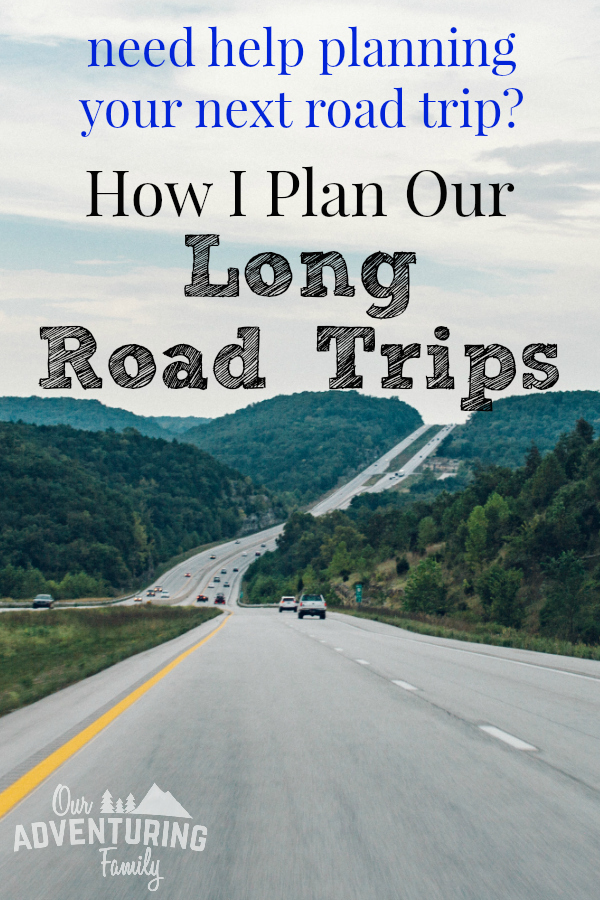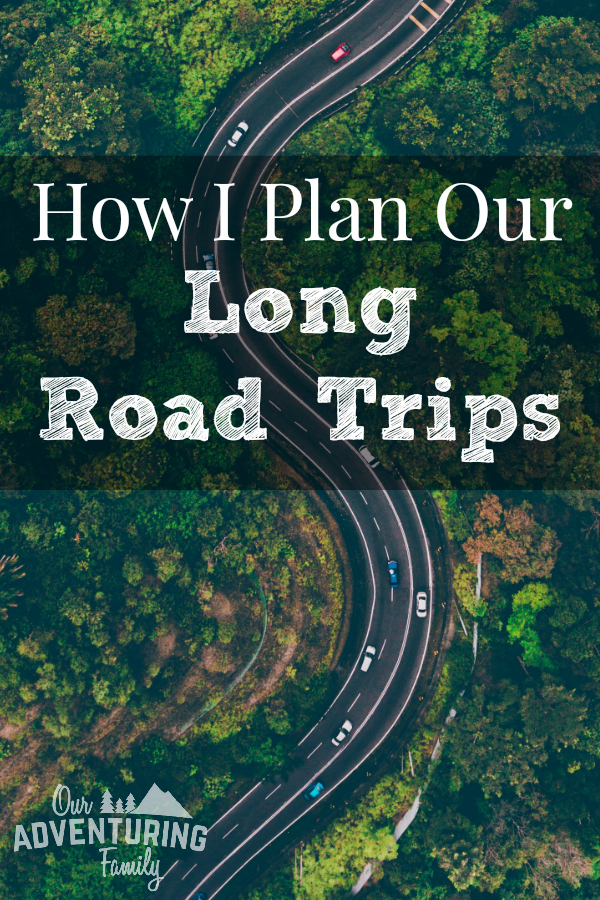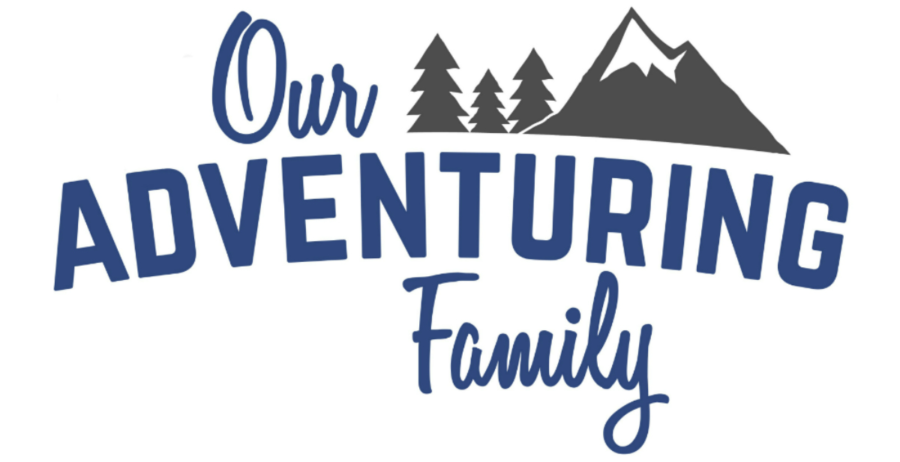This post may contain affiliate links. As an Amazon Associate I earn from qualifying purchases, but there is no additional cost for you. Please see my Disclosure page for more information.
We take long road trips every other summer with multiple shorter trips in between. Our shorter trips are usually to a single destination that we can drive to in one day, but on our long road trips, it takes several days to get to our destination. Those trips are always to two family reunions, so we have to figure out how to make the dates and locations work with the amount of time that Jeremy can get off work.
Sometimes we have time to meander our way across the country, stopping at national parks or other points of interest along the way before arriving at the first reunion. Other times we’re driving as far as we can each day, trying to get to the reunion (or back home) as quickly as possible.
Regardless of whether we have time to explore or we’re trying to cover as much distance at a time as we can, I follow the same basic framework when I plan our long road trips. This framework will help you plan your own long road trip.
How I Plan Our Long Road Trips
1. Gather some materials
I find it’s easiest to do the necessary research if I have my laptop, my phone, my planner, and a pen and paper (or an open word document).
2. Gather information
I gather a list of dates: dates of reunions, approximate dates Jeremy has off work, and any other firm time commitments that need to be accommodated. Then I make a list of potential places we can stop at along the way, as well as the locations of the reunions (these change every time).
3. Play with the information
Route & sightseeing stops
First, I enter our starting location and our destination into Google maps on my laptop and take note of the total miles and hours for that trip. Then I start adding stops that we’d like to make along the way. If I didn’t add them in geographic order, I fix that. If a stop is too far away from our route I evaluate whether another route would make sense, and if not, how badly we want to go to that stop. Sometimes an out-of-the-way stop stays in the itinerary, sometimes it doesn’t. I aim for a good balance of driving time and stops.
While I’m working on the route and the stops we’ll make, I’m also keeping in mind how much time we have for that portion of the trip. If the reunions are spread further apart then usually the time crunch happens on the way to and from them. If the reunions are closer together then we have a bit more time to play with and we can make more stops as we drive to or from them.
So yes, sometimes we do have some long driving days (this is how we keep the kiddos from going crazy). But we try not to do it two days in a row, and we break things up as much as possible with stops to get out and stretch our legs.
Overnight stops
Once I have the stops figured out, I decide how much driving we’ll do each day and where we’ll be spending the night. I usually have a good idea of how long everything will take and how long each day will be. If we’re not spending the night at one of our stops, then I’ll play around with Google Maps, picking towns along our route that I think will put us at about the distance we want to cover for that day. Once I’ve got an idea of the area we need to end up in, I start looking for places to stay.
I hate spending money if I don’t have to, so first I’ll look on the AllStays app on my phone for BLM or national forest land, rest areas, truck stops, Wal-Marts, Cabelas, or Cracker Barrels in the area. Most of these places will allow free overnight parking, though not all do, due to zoning differences. If I find one of these locations on the AllStays app and the reviews look good, I add it to the itinerary.
If I can’t find a good spot for boondocking, I pull up the Thousand Trails website and look for any TT campgrounds in the area (use this link for $100 off your annual membership fee). But if I can’t find one of those, then I check the AllStays app again and see if there are any military campgrounds in the area (they’re usually pretty inexpensively priced). If not, I check the Passport America site (use my ID number R- 0313853 to get 15 months for the price of 12) and the Harvest Hosts site (use this link to get 15% off your annual membership) to see if there are any spots we can stay at. When I do find a Harvest Hosts spot, I double check the itinerary to make sure we’ll be able to arrive during business hours. If we can’t, I keep looking.
At this point, if I’ve exhausted all my preferred options, I expand my search even more. I go back to the AllStays app and look for any campgrounds in the area. If I’m still not finding anything, I’ll go to Campendium and RVParky and search there. Most areas won’t take this long to find a suitable spot to stop for the night, but occasionally it does, like when I was looking for an overnight spot in the middle of Wyoming. There was a BLM campground if we backtracked an hour from a spot we wanted to stop and explore, but we didn’t have room in the schedule for backtracking. I finally found a campground mentioned on Campendium, but the campground doesn’t have a website and doesn’t do any advertising so it was very difficult to get any information on it.
4. Review the itinerary and make any needed changes
After I have the itinerary figured out with how far we’ll drive each day, stops we’ll make, and where we’ll stay, I go over it with Jeremy. He doesn’t have the time, or the desire, to work through all the calculations and changing things around to make things work, so I do the legwork and then share it to him. If he’s good with the itinerary, then I make any necessary campground reservations and we’re good to go. If he brings up any issues I missed, then it’s back to the drawing board to get it right. This actually isn’t a huge deal as I do enjoy the process.
~~~~~
Long road trips do take some prep work, but are a lot of fun, especially if you stay flexible and don’t stress about how things do or don’t turn out.
How do you plan your long road trips? I’d love to hear your process!

What this looks like in real life
Two years ago we had a reunion at Zion NP in southern Utah and on our way to it our route took us near a Little House on the Prairie site in Kansas. We made the short detour to see it (and happened upon a festival), then continued on our way to Zion NP. After the first reunion, we had about a week and a half to ourselves, and then the second reunion in eastern Idaho.
Once we knew the dates and locations of the reunions I did some research on places we could visit in between the reunions. My 40th birthday fell in that interval and after visiting friends on our way north through Utah we drove up to Glacier NP so I could run the Glacier half marathon on my birthday (this was the final run in my 40 by 40 goal). We explored the park then drove up to Waterton Lakes NP in Canada before dropping back down into Idaho and driving to Boise to visit family before going to the second reunion.
After the second reunion, we took a more northerly route than we usually would, which allowed us to visit a Little House site in Minnesota (we missed a third site in Wisconsin when we couldn’t get there before they closed). We also drove through Michigan’s Upper Peninsula and crossed the Mackinaw bridge before heading south through Michigan and back home to Virginia.
That was a five-week trip, so we had a little bit more time to explore than we will during this year’s three-week trip. But regardless of the time available for the trip, there’s some things to keep in mind as you plan your trip.
Some things to keep in mind
1. Decide on how much driving you’re willing to do each day, and make sure it’s a realistic number. 16 hours of driving in one day is not a realistic, or safe, number. We would prefer to do no more than 4 or 5 hours of driving a day, but unfortunately, our schedule rarely allows for such a leisurely pace.
2. Don’t forget to factor in how long you’ll be at each stop, as well as stops for gas, meals, and potty breaks if they don’t line up with your planned stops. They always take longer than you think they will.
3. If you’re not sure which extra stops to make along your route, do some research. Do you like visiting state or national parks? Google each state you’ll be driving through and see if there’s any state or national parks near your route that look interesting. If you’re interested in something else like the best BBQ, raceways, quilt shops, or whatever, Google will help you find them. It never ceases to amaze me how many signs for quilt shops I see on the freeways.
4. Be flexible. Accept that you might not be able to visit every site on your itinerary if you’re going to keep to your timetable, or if it just doesn’t fit in, like that third Little House site we wanted to visit. We were running a little late and with the small detour needed to reach it, it would have been 9 pm before we arrived. Needless to say, there was no point detouring to visit a closed site in the dark. If you’re determined to visit every site, you may have to be willing to arrive at your destination a little later than planned.


